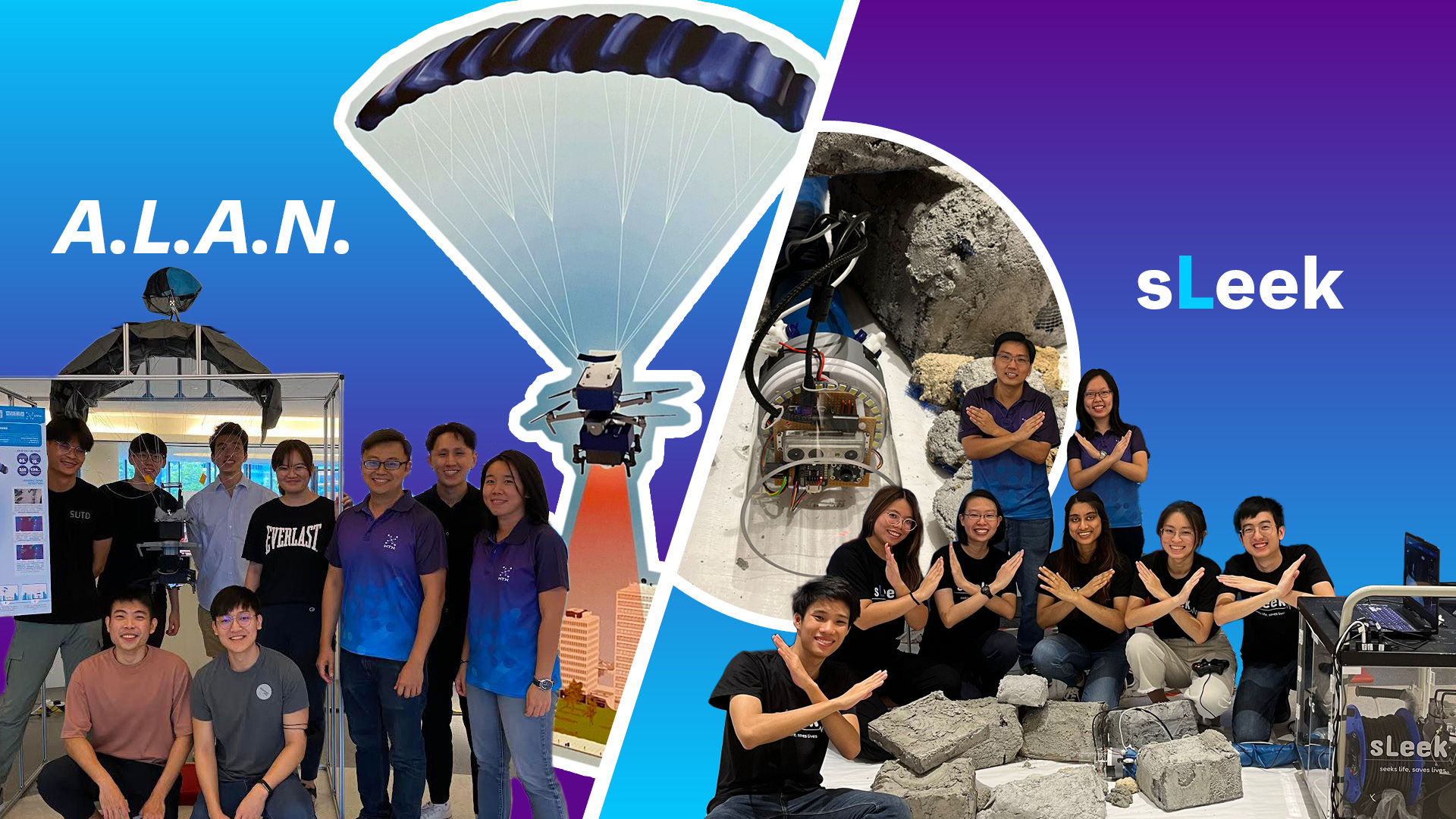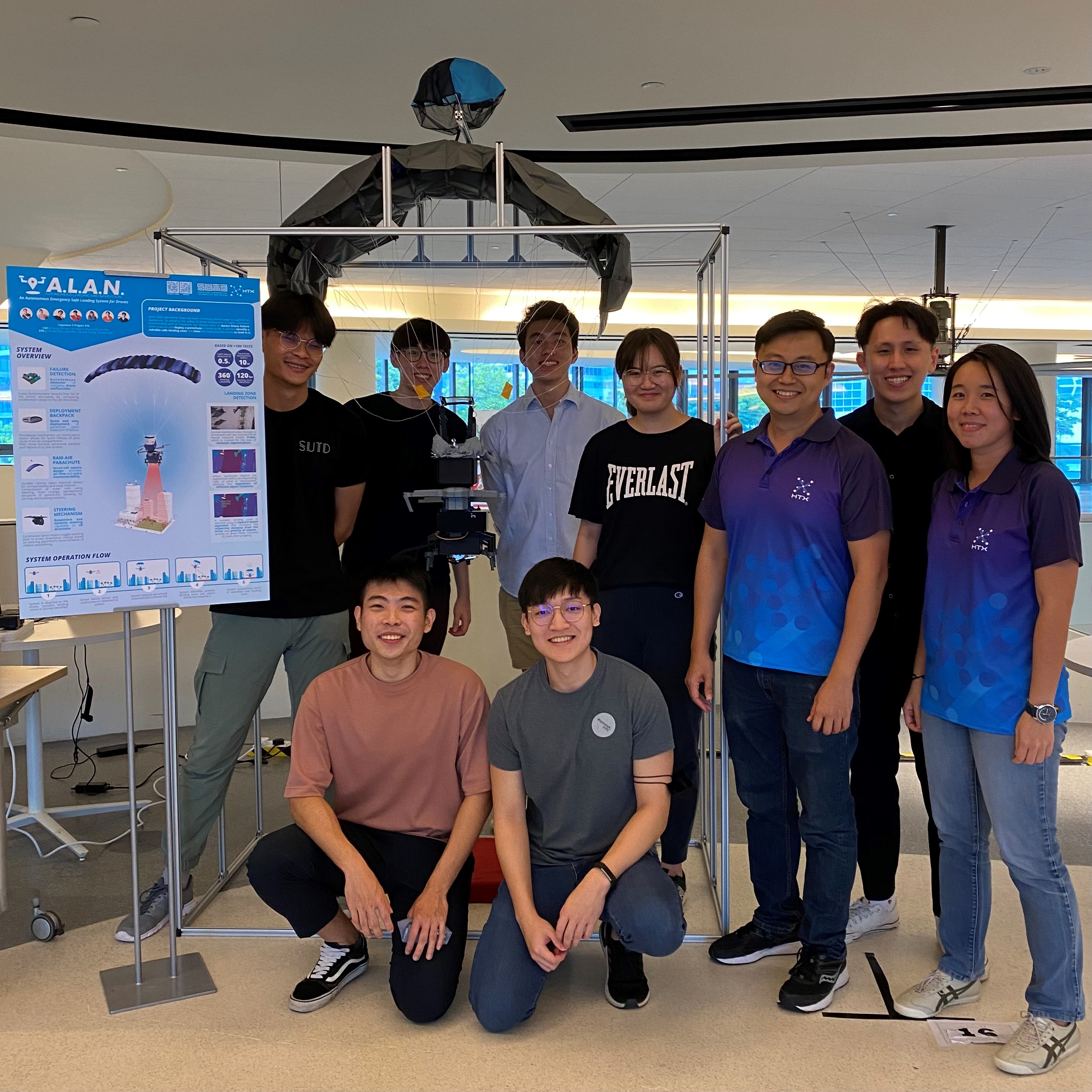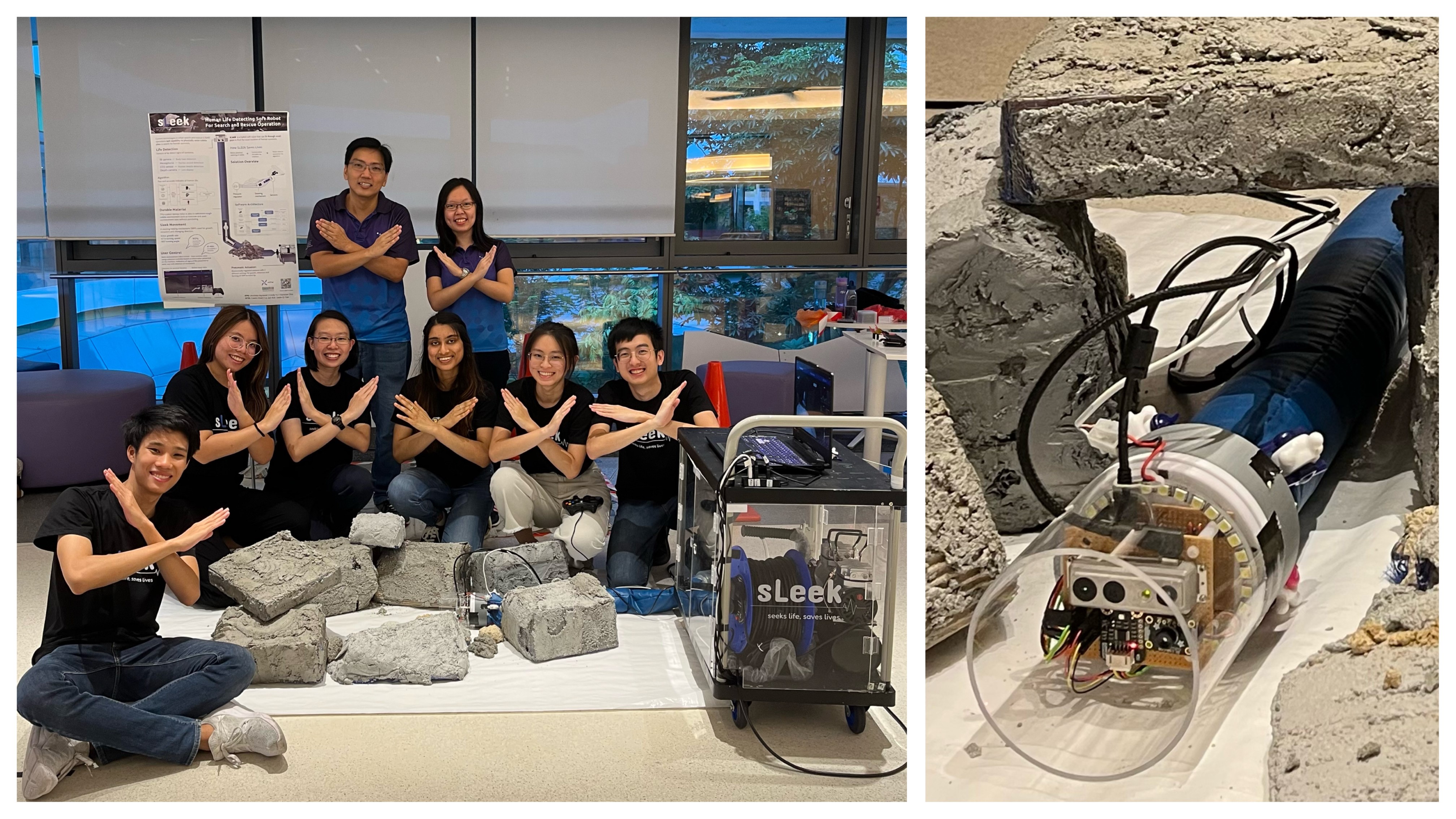
A parachute system that can guide a malfunctioned drone to a safe landing location and a ruggedised life-detecting soft robot were two innovative prototypes showcased by final-year students at the Singapore University of Technology & Design’s (SUTD) Capstone Design Showcase 2022 on August 5.
The capstone showcase is the culminating event for the students’ final year projects, where SUTD students pursuing different degree programmes come together in multi-disciplinary teams and collaborate with industry partners to solve real-world challenges.
The students behind the two projects “A.L.A.N. for emergency drone landing” and “SLEEK: Soft Robotics for Survivor Search after Structural Collapse” were mentored by engineers from HTX’s Robotics, Automation & Unmanned Systems (RAUS) Centre of Expertise (CoE).
“SUTD’s capstone programme provides a platform for young engineers to have a glimpse of the work HTX does to enhance Home Team operations and apply their engineering knowledge through hands-on development of functional prototypes,” said Lee Guoming, Deputy Director, Aerial Systems, RAUS CoE. Guoming had mooted the idea of collaborating with SUTD students on their capstone projects two years ago, in HTX’s first year.
A.L.A.N. for emergency drone landing
A.L.A.N. (Autonomous Landing and Navigation) is a parachute system that deploys automatically when a drone malfunctions mid-flight and free falls from the sky. It uses computer vision to steer the malfunctioned drone to a safe landing zone away from people, vehicles, and property. The project team comprised Chung Zhi You, Lim Hng Yi, Lim Ken Zho, Marcus Ho Jun Wei, Sumi Boo, Tan Jee Chong, and Timothy Lim Yee Da.
Watch a video about A.L.A.N. for emergency drone landing here:
There are currently no autonomous solutions that have both navigation and steering capabilities to guide a malfunctioned drone to a safe area for landing. A.L.A.N. enhances drone safety in densely populated and highly urbanised environments, such as in Singapore.
“When a drone malfunctions, a lot of solutions out there can only do things such as break the fall of the drone so that it doesn’t get damaged, and don’t consider whether there is a risk of causing harm to people, property or vehicles,” said Sumi Boo, an engineering product development student.
“We have developed an end-to-end solution to ensure that when a drone malfunctions, it will be able to land safely and avoid any obstacles,” Sumi said. “We were able to apply our technical knowledge and were also able to bounce a lot of ideas off our HTX mentors during our ideation as they are experienced engineers.”

(Clockwise from top left) SUTD students Lim Ken Zho, Timothy Lim, Marcus Ho, Sumi Boo, Tan Jee Chong, Chung Zhi You, and Lim Hng Yi with HTX engineers (in purple) Lee Guoming and Stacia Chua at SUTD. In the centre is the A.L.A.N. prototype. (Photo: HTX/ Michelle Lim)
“A.L.A.N. is the first attempt by HTX, in collaboration with the students, to address safety concerns in the event of drone malfunction during flight,” said Guoming, who leads a team of engineers working on aerial systems, such as drones. “The prototype developed by the students proves that the concept of a ‘smart parachute’ is a viable one.”
“With further fine tuning and miniaturisation, it can potentially be a deployable solution that will enable greater regulatory and public acceptance in the use of drones for Home Team operations from safety perspective,” Guoming said.
He was also involved in two other drone-related capstone projects. “Ultra-wide Band Beacons for Drone Navigation” is a beacon-based localisation system for seamlessly navigating drones in built-up areas where the deployment of drones could be challenging due to GPS multipathing, which can cause drone malfunctions.
The project “Drone Wayfinding and Airbag System in a Modern Cityscape” is an automated flight path planning and modular airbag system that reduces the impact energy of a free-falling drone to minimise potential damage.
Read related article: HTX's First Long-Distance BVLOS flights a milestone for Home Team Ops
SLEEK: Soft Robotics for Survivor Search after Structural Collapse
(Top left to right) HTX engineers Ong Ka Hing and Aw Rui Huan with (bottom left to right) SUTD students Lo Jun Kai, Seah Qi Yan, Vanessa Chia, Anshiqa Agrawal, Cindy Yu, and Cawin Chan doing the quintessential HTX “X” pose. On the right is a close-up of the robot’s sensors. (Photo: HTX/ Michelle Lim)
A group of six students – comprising Anshiqa Agrawal, Chan Jun Hern, Cawin, Lo Jun Kai, Seah Qi Yan, Vanessa Chia Yun Yao, and Yu Yuan Hua Cindy – undertook the challenge of improving the efficiency of searching for survivors in rubble by search-and-rescue personnel, using sensors and soft robotics.
The team, mentored by Ong Ka Hing, Deputy Director, Ground Systems, RAUS CoE, designed a ruggedised life-detecting soft robot that can crawl through tight spaces between rubble pieces and rough terrain after a building collapse.
The semi-autonomous robot has an artificial intelligence-based sensor system that hears and looks for trapped survivors using microphone, carbon dioxide and infrared camera data, with the information displayed intuitively displayed on a customised user interface.
Watch a video about SLEEK: Soft Robotics for Survivor Search after Structural Collapse here:
“This was quite a challenging project as people have not really explored soft robotics for disaster use. There was no industry standard for us to follow and we had to start from ground zero for this idea,” said team leader Qi Yan, a computer science student. “Our HTX mentors were very supportive and gave us a lot of feedback and advice on how to design the robot.”
To help the students better appreciate the real-life scenarios for disaster assistance and create a realistic environment for the development of the robot, Ka Hing arranged for the students to speak with SCDF officers to understand their concept of operations. They also helped the students to set up a rubble site on campus.
“It has been a great joy working with the students. They were willing to think out of the box and used soft robotics as a possible solution for an extremely difficult problem statement,” Ka Hing said. He currently leads a team of engineers that are developing an array of on-ground robotics solutions for the Home Team, such as the robotic dog Rover-X, autonomous ground robot Xavier, cyborg cockroach, and common robotics dashboard.
“Although there were technical challenges and hiccups along the way, the team has shown tremendous spirit and their “Dare to Try” attitude resonates with HTX’s culture of innovation,” Ka Hing said.
Building the ecosystem of robotics talent
“It is heartening to see young talents from different engineering disciplinary backgrounds come together to solve real world problems in line with HTX’s mission to advance science and tech to force multiply the Home Team,” said Cheng Wee Kiang, Director, RAUS Centre of Expertise, at HTX.
“We believe in doing our part to nurture the young robotics and automation talent in Singapore,” he said. “There are tremendous opportunities to be harnessed for greater good as we continue to push boundaries and innovate together for the future.”
Read related article: Taking Strides Forward to Deliver the Home Team Robotics Strategy

